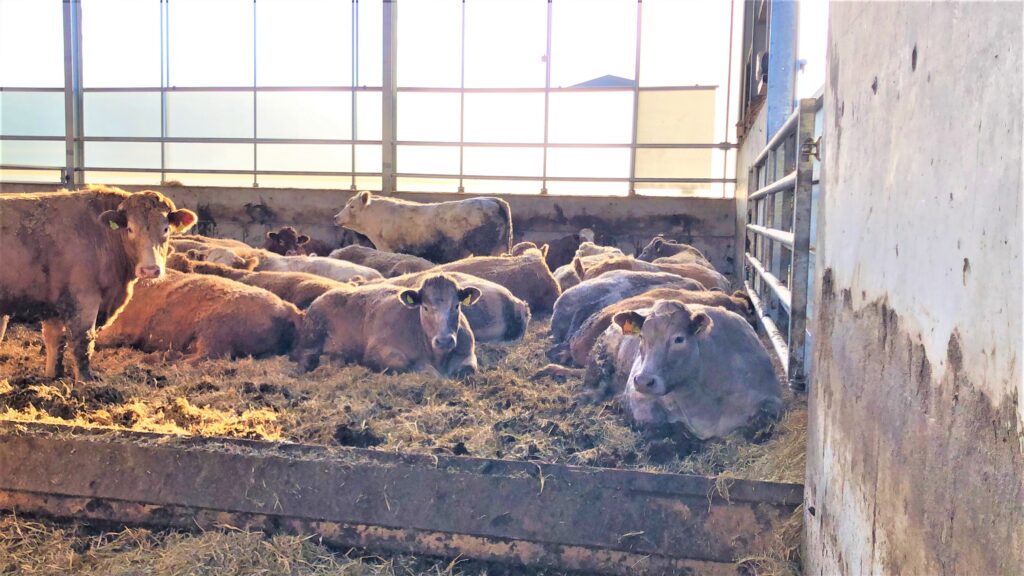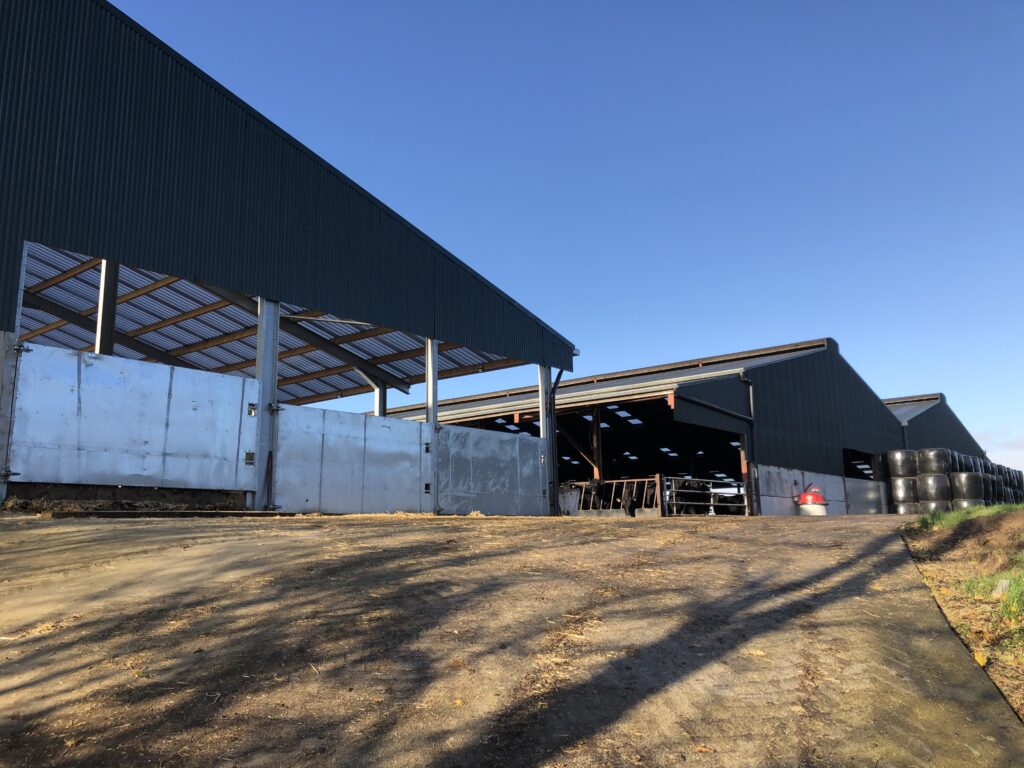As part of the Beef Focus Revisit series for the Christmas season, Agriland has taken a look back at some of the farmers involved in the Irish cattle business who featured in the Agriland Beef Focus series this year.
In November this year, Agriland visited Foyle Food Group’s ‘Farms of Excellence’ in Co. Tyrone. The overall farming operation encompasses 1,100ac of land. 570ac of this is mountain-type ground, 250ac is lowland grazing and the rest is lowland silage ground.
The farm is continuously conducting research and trials with the aim of providing practical and up-to-date information to Foyle’s beef suppliers on ways to further improve the economic and environmental sustainability of their farms.
Some of the areas on which the farm is currently conducting research includes best practice on grassland management, soil health, animal nutrition, and bedding for livestock.
Procurement director at Foyle Food Group, Wayne Acheson, explained there are three parts to the farm: “Our hill farm aims to demonstrates suckler-beef systems using high genetics.
“Our grassland farm aims to show best practice through paddock grazing multi-species swards, and our beef finishing farm aims to show farmers best practice with housing design, bedding, feed additives and a key focus on animal welfare.”
The farm manager is Darragh McManus and a team of staff help him with the daily management of the farm.
The Foyle suckler unit
The Foyle farm currently has 120 suckler cows and is in the process of expanding their suckler herd to 200 cows.
The herd is calved indoors in March and once the cows calve, they go straight out to the fields near the farm where they graze until mid April. Once conditions allow, the cows and calves go to the mountain for summer grazing.
Calves are weaned gradually in November using quiet wean devices and once weaned, the cows are housed until calving time in March.
The weanlings stay outside on the low ground grazing platform and also graze off the silage ground. They are generally housed for a month in February when conditions become too wet.

These cattle are then let back to grass for the second grazing season and are housed for finishing when they hit approximately 550kg liveweight.
This year, the spring 2021-born cattle were finished after 45 days feeding in the shed at an average carcass weight of 354kg and averaging an R grade at 19 months of age.
Wayne explained: “We are currently building the herd up to 200 suckler cows so the heifers all went back for breeding this year.”
The blue-grey cow
All heifers are calved at 24 months of age. Commenting on the breed of suckler cow kept on the hill farm, Wayne explained: “We start off with a Galloway and we breed them to a white shorthorn to get a blue-grey for the hill ground.

“We have a sandy type hill farm in Pomeroy which we keep half-bred Angus cows on and then breed them to Angus bulls, so we get a 75% Angus calf off them.”
The main objective of the ‘Hill Suckler Project’ is to demonstrate that a medium sized suckler cow in a hill setting served with a high genetic sire can produce a superior weanling which will finish in-spec at a younger age. All this is done in a low-cost system.
Andrew Clarke, from Foyle Food Group’s agriculture and procurement sector, added: “What we’re looking for is a low mature weight cow with high maternal traits that we breed with an Aberdeen Angus bull that is in the top 1% genetics of the breed for maternal and terminal traits.
“When we’re picking a bull, we’re looking for short gestation, easy calving and good growth figures.”
The lowland pasture
There is approximately 250ac of land dedicated to lowland paddock grazing. This is split into 16ac blocks.
The farm grazes roughly 1,200kg liveweight/ac and the aim is to achieve 400kg of liveweight gain/ac/year.

Wayne explained: “We have cattle at 400kg going to land and we will graze them on a 32-day rotation on the multi-species and the ryegrass is a 21 day rotation.”
The stocking rate is gradually built up as the grazing season commences and from late July, the heavier cattle are drafted off for finishing.
Multi species
The farm first introduced multi-species swards (MSS) in 2019 when it joined the European Innovation Partnership (EIP) project on multi-species swards for beef and sheep.

Commenting on the new grazing sward venture, Andrew said: “We’re still fine tuning the management of MSS but what we are seeing is we have not used any anthelmintic products to treat parasites on cattle that went to MSS.
“Cattle are performing equally on multi species and perennial ryegrass but we have had no chemical inputs on our multi species.
Tow and Fert
The farm is placing a bigger focus on feeding the soil with biological enhancing products and to do this, it invested in a Tow and Fert sprayer this year.
Andrew explained: “It has two functions. We are using it to apply products like molasses and Humac to feed the soil micro-organisms and encourage plant growth.

“The lime flour helps to feed the high calcium demand of legumes and we apply it on a ‘little and often’ basis during the growing season.”
While the MSS receives no chemical fertiliser, the perennial ryegrass swards receives foliar fertiliser at half the rate of granular fertiliser applications.
The foliar fertiliser is applied 11 days post grazing and the application consists of granular Urea mixed with water in the Tow and Fert.
Wayne added: “When we bought the Tow and Fert, we reckoned it would take three or four years for it to pay for itself but when fertiliser prices increased, it will have itself paid for in one and half years now.
“We don’t spread any granular fertiliser now, the fertiliser sower is parked up and we might have to sell it,” he commented.
All grass growth is measured by cut and weigh on a weekly basis. Roughly the farm grows 10t of Perennial ryegrass and 10t of the MSS.
The farm has also seen the population of earthworms grow in the MSS and, because no wormers are being used, the populations of dung beetles is also increasing.
Foyle Finishing unit
The finishing unit on the farm finishes from 80-100 cattle per week or approximately 4,500 cattle per year. There are a combination of 30-, 60-, 90-, and 120-day-kept cattle on the finishing unit.
The aim of the finishing unit is to show farmers the best practice in finishing cattle and to supply cattle to the Foyle Omagh and Foyle Campsie sites.
The finishing unit is involved in a knowledge transfer partnership (KTP) with South West College and is looking into more efficient ways of utilising farm inputs such as bedding and feed.

Slurry from the finishing unit is treated with enzymes and bacteria to reduce agitation time and bedding is treated using a process known as ‘bokashi‘.
Because access to bedding materials is limited in the region and straw is costly, getting the most out of the materials used is of huge importance to reduce bedding usage and improve the efficiency of the materials.

Bedding is composted and the bed under the cattle is rotovated daily. The heat of the compost process dries the bed and, as it gets damp, more fresh bedding is added.
When the bedding is cleaned out, it is covered for eight weeks and fermented anaerobically.
New shed
A new shed was completed this year which has the capacity to house 180 cattle. The shed is 48m long and 20m wide, with an 8m slatted area and a 12m dry-bedded area.
The bedded area is on a precast slab above a tank with perforations to allow dampness from the bedding to seep into the tank.

The new shed was designed as part of the KTP and has a mono pitch roof sheeted with transparent sheeting. It is designed to catch sunlight on the bedded area.
The open space behind the bedded area has a windbreak which is linked to a weather station on the roof of the shed. In windy conditions, the windbreak rises and in calm conditions the windbreak lowers automatically.
There is a bubbling system in the slurry tank to eliminate the need for agitation.
Finishing unit feed programmes
Cattle are fed total mixed ration (TMR) using a tractor and diet feeder. The amount of food not eaten is accessed every day and the ration is altered according to this.
The table below is an example of a typical TMR and typical beef blend used on the Finishing unit:
Typical TMR Typical beef blend Feed plan Kg/head/day Ingredients Kg/head/day First cut silage (28% DM) 16kg Maize meal 3.194kg Brewers grain (21%DM) 6kg Rolled barley 1.638kg Molasses feed cane – FGN 1.5kg Sugar beet nuts 1.638kg Chopped hay 0.5kg Rapeseed meal 0.334kg Beef Blend 7.5kg Rumin Aid 250 0.225kg GlycoPass 0.225kg Beef thrive mineral 0.112kg Urea (feed grade) 0.084kg Rumenate 0.030kg Elensis 0.018kg
The beef blend is premixed seperatley to the TMR to improve the accuracy of the ingredients included.
The diet is fine-tuned because cattle are performing highly. Wayne explained: “It is hard to determine how the 30-day cattle are performing but the 60- and 90-day cattle are achieving an average daily liveweight gain of 1.6kg/day to 1.8kg/day.

“Angus cattle off our grazing platform did 1.7kg/day this year. We built them up on meal before they came in but once they were housed, that’s what they did”.
All cattle on the farm get the same diet. However, new cattle are gradually transitioned onto this diet.
Wayne explained: “A 90-day finish animal will start off at 50% of the diet with ad lib straw and will gradually be built up over 14 days. A 60-day finish animal will start at 70% of the ration and ad lib straw and will be built up over 10 days. 30-day cattle go straight on to the finishing ration.
All cattle entering the finishing unit are vaccinated for Infectious bovine rhinotracheitis (IBR), and a check-in protocol on treating external and internal livestock parasites is adhered to.
Automatic cattle brush
As part of the research of the Foyle KTP partnership, the farm examined how environmental enrichment could effect the performance of cattle. As part of this, an automatic swinging cattle brush was installed in one of the pens.

The second trial has been completed and early indications are showing a 0.2kg/day increase in liveweight gain from cattle in the pen with the brush.
It has also been noted that cattle spend longer times lying and in the pen with the brush. The farm is now looking to place additional brushes in the other pens to see if the trial’s results can be replicated.
Looking to the future, the Foyle farm aims to continue its research and demonstrate to farmers how better cattle genetics and adapting new management practices can all help to improve the economic sustainability of beef farms while reducing the industry’s carbon footprint and becoming more eco-friendly.
